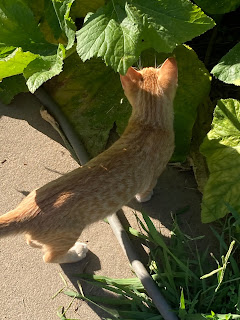 |
| Mango |
The Sacramento County Shelter likes prospective kitten owners to fill out a lot of paperwork before any adoption can take place. I clearly remember one question that the Bradshaw Shelter posed: "What do you expect your new kitten to do?" I nearly put down something snarky like "croon like Frank Sinatra," but I had second thoughts. I just put down the following: "be a typical kitten."
 |
| Bandit and Mango |
They are my new Frick and Frack.
The second reason why I adopted Mango was out of pure garden frustration. An army of rats, opossums, skunks, birds, and other wildlife regularly assaulted the large gardens that I planted the previous two years. The large heirloom tomato crops were chewed up and eaten. Every kernel of Golden Bantam corn was stripped away and consumed. The California Wonder Bell Peppers were hauled off and spirited away. My nightly garden raiders even developed a taste for Yellow Crookneck Squash!
 |
| Garden in July |
I've faced raids by rats in the past. In my North Natomas gardens they would drop in from time to time to filch a tomato or a mandarin. They might have even drilled a hole into a watermelon. But that damage was minor. I could live with one or two missing tomatoes. I could lose one watermelon or cantaloupe and "be one with nature."
But the garden raids that started two years ago were like nothing I had ever witnessed or experienced before. I had never before lost an entire crop of Brandywine tomatoes. Watching 60-70 Lemon Boy tomatoes suddenly vanish in the space of a week was simply too much to bear.
 |
| Tiny Kitten |
Rats aren't stupid. They are, however, destructive.
Enter Mango. Stage right. I didn't really have high hopes. After all, the boy I had adopted was just a kitten. How is a small kitten going to stop a big and nasty rat? Or, more to the point, the 101st Airborne Rat Army? These are big, nasty, mean and hungry creatures. Will a kitten really stop them? A tiny orange ball of fluff?
 |
| Garden Enforcer at Work |
Mango's education as a garden enforcer started with small prey. My boy began to haul small bugs into the house. Much to my horror, I realized those small bugs were, in fact, cockroaches. There's nothing quite like the feeling of dread that washes over you when the kitten hauls in a big, fat, fast cockroach and then drops it on the carpet.
Cockroaches run very fast. They head for the nearest dark crevice of safety, where they can set up a new home and produce lots of other cockroaches. That's what these bugs intended to do. Unfortunately, none of them were fast enough. Just before they could reach any measure of safety, Mango would catch them, flip them in the air, pick them up, bite them and start the entire play process all over again. When the roach stopped moving, he ate it. Every last bit of it. Munch, munch, munch.
You and I like popcorn, right? Perhaps a crunchy bell pepper? Tree-ripened fruit perhaps? My cat likes cockroaches. A lot. Deal with it. When he decimated the cockroach population in my yard, he took his hunt to the next door neighbor's house. The neighbor did not complain. Not one iota.
 |
| Squash Plant Patrol |
But, the biggest test is yet to come. The Garden Enforcer is doing his job, so far. However, the main crop of heirloom tomatoes has yet to ripen. While Mango has already prevented many raids from taking place, the real test will come in August, September and October.
 |
| Zero Damage |
But, will it last? Stay tuned. The Kitten Chronicles, featuring Mango the Garden Enforcer, will continue.






.jpg)







